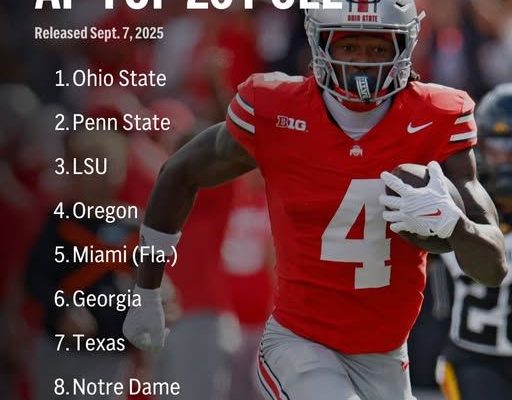Ohio State, Penn State, and LSU continued to dominate the landscape of college football, maintaining their positions as the top three teams in The Associated Press Top 25 poll released Sunday. Each of these programs has demonstrated remarkable consistency and resilience through the early and mid portions of the season, reflecting not only the strength of their rosters but also the strategic brilliance of their coaching staffs. Ohio State, still at the pinnacle of the rankings, has showcased a potent combination of offensive firepower and defensive solidity. Their quarterback play has been particularly impressive, demonstrating both mobility and accuracy, which has allowed them to adapt to various defensive schemes. The Buckeyes’ offensive line has been a cornerstone, providing protection and creating lanes that have made their running game nearly unstoppable at times. Defensively, Ohio State has relied on a disciplined secondary and aggressive front seven, creating turnovers and limiting big plays, which has been a hallmark of their early season success.
Penn State, ranked second, has consistently matched Ohio State in intensity and execution. Their offense has balanced aerial and ground attacks, keeping defenses guessing while maximizing the talent of their skill players. The Nittany Lions’ running backs have provided explosive playmaking ability, complementing a quarterback capable of both precision passing and making plays under pressure. Penn State’s defense has also been notable, with a linebacker corps that combines speed and strength, effectively disrupting opposing offenses before they can establish rhythm. Special teams play has contributed to the Nittany Lions’ high ranking as well, with a combination of precise kicking and strategic returns often setting the tone in close contests. The team’s ability to maintain discipline while executing complex plays has been a critical factor in their sustained position near the top of the rankings.
LSU, holding the third spot, has impressed with an offense that blends speed, versatility, and physicality. The Tigers have consistently demonstrated a capacity to score quickly while maintaining possession when necessary. Their wide receivers have been dominant in creating separation and turning short passes into significant yardage, while the running game has been both dynamic and reliable. On the defensive side, LSU has excelled in applying pressure on opposing quarterbacks, generating sacks and forcing hurried throws that lead to turnovers. The Tigers’ defensive line and secondary coordination have allowed them to remain competitive even against high-powered offenses, which has been essential in solidifying their top-three ranking. LSU’s special teams, often an overlooked aspect, have contributed crucially through field position management and clutch kicking, further cementing their status as one of the nation’s elite programs.
While the top three have remained stable, significant movement has occurred outside the top 10, illustrating the competitive nature of the 2025 season. Teams that previously hovered in the mid-teens of the poll have made substantial gains through decisive victories and strategic improvements. For instance, several programs have leveraged high-scoring offenses to leapfrog competitors, emphasizing the importance of explosive playmaking and efficient scoring drives. Meanwhile, teams that experienced early setbacks have begun to climb as their rosters settle and coaching adjustments take effect. These shifts underscore the fluidity of college football rankings and highlight the impact of every game, no matter the perceived strength of the opponent.
One notable trend in the top 25 is the emergence of mid-tier teams making statements through dominant wins over ranked opponents. These victories often involve balanced offensive execution, where running and passing games complement each other, creating unpredictable threats for opposing defenses. Additionally, defensive units that generate turnovers and limit big plays have propelled teams upward, demonstrating the importance of a holistic approach to the game. Teams that can combine tactical ingenuity, athleticism, and depth are often rewarded in the rankings, reflecting the multidimensional nature of modern college football. Coaching adjustments during games have also played a significant role, as timely halftime strategies and in-game adaptations often determine the outcome of closely contested matchups.
Another factor contributing to shifts in the rankings is player development and injury management. Programs that effectively rotate players, maintain depth at critical positions, and nurture emerging talent have been able to sustain performance despite the grueling nature of the season. Quarterbacks who can adapt to defensive schemes, wide receivers who excel in route precision, and running backs who maintain consistency against formidable defenses are often key differentiators. Likewise, defensive players who can read offensive formations, anticipate plays, and execute tackles efficiently are invaluable. Injuries, when managed carefully, do not derail teams’ progress but rather provide opportunities for younger or less experienced players to prove themselves, which can have lasting effects on both rankings and team morale.
The poll also reflects regional dynamics and conference strength, with the Big Ten and SEC continuing to assert dominance. Ohio State and Penn State’s presence at the top highlights the Big Ten’s continued influence, while LSU underscores the SEC’s ability to produce elite-level programs consistently. This regional representation has implications for the College Football Playoff and potential bowl games, as conferences with multiple top-ranked teams often create competitive matchups and enhance the national appeal of their schedules. Conference play has been particularly instructive in evaluating team quality, as matchups between historically strong programs often serve as de facto playoff previews, influencing voter perceptions and ultimately shaping the AP Top 25.
In addition to the top 10 stability, teams in the 11–25 range have been dynamic, with several programs making significant moves based on recent performances. Upsets, decisive wins against ranked teams, and strong statistical showings have all contributed to reshaping this portion of the poll. Teams that combine offensive efficiency, defensive resilience, and disciplined special teams play have been rewarded with higher placements, while those that falter in any of these areas have slipped. This ebb and flow is emblematic of college football’s unpredictability and the necessity for consistency across all facets of the game. Voter sentiment is influenced not only by wins and losses but also by the manner in which teams achieve those results, including the quality of opponents defeated, scoring margins, and overall execution.
Analysts have noted that while Ohio State, Penn State, and LSU remain dominant, the landscape beneath them is fertile with potential challengers. Programs that demonstrate mid-season surges, particularly through high-profile wins, are capable of breaking into the top tier by the time postseason selections are finalized. This dynamic keeps fans engaged and ensures that every game carries significant implications, not just for the teams directly involved but also for the broader ranking ecosystem. The AP Top 25, while reflective of current performance, also anticipates how teams might fare in playoff scenarios, adding an element of projection that blends objective results with informed speculation.
The importance of quarterback play cannot be overstated in the current rankings. Teams with versatile, confident, and accurate signal-callers have been able to maintain offensive momentum and capitalize on defensive lapses. The interplay between quarterback decision-making and offensive line performance has often determined the success of high-ranking teams, particularly in closely contested matchups. Conversely, teams that struggle with turnovers or inconsistent quarterback performance often face downward mobility in the poll, regardless of other strengths. This emphasis on leadership and execution under pressure aligns with broader trends in football, where precision and adaptability are as critical as raw athletic talent.
Looking ahead, the remainder of the season promises further movement within the AP Top 25, especially as conference play intensifies and teams face critical matchups with playoff implications. Injuries, adjustments, and emerging talent will all play roles in shaping the landscape. Fans can expect that while Ohio State, Penn State, and LSU may maintain their positions in the immediate future, challengers from within and outside the top 10 will continue to make compelling cases for upward movement. Every victory, margin of dominance, and strategic execution will influence the rankings, making each week a crucial chapter in the narrative of the season.
Special attention should also be given to the intangible factors that influence rankings, such as team morale, coaching experience, and the ability to handle high-pressure situations. Programs that maintain composure, execute consistently, and respond well to adversity often outperform expectations, climbing the rankings even when external factors suggest limitations. This aspect of college football underscores the human element in the sport, reminding fans and analysts alike that preparation, discipline, and resilience are as vital as physical skill.
In conclusion, the latest AP Top 25 college football poll underscores the strength and consistency of Ohio State, Penn State, and LSU while highlighting the dynamic nature of teams outside the top 10. The season thus far has demonstrated the critical importance of balanced offensive and defensive play, the impact of coaching strategy, and the necessity of depth and adaptability in a grueling schedule. While the top three remain established, the movement among mid-tier programs reflects the competitive depth of college football in 2025, keeping fans engaged and analysts busy predicting outcomes. The interplay of performance, strategy, and emerging talent will continue to define the rankings as the season progresses, ensuring that every game carries weight and that the path to the College Football Playoff remains open and fiercely contested. With the rankings shifting based on each week’s outcomes, fans have the opportunity to watch not only the top-tier teams but also the emerging programs striving to prove their place among college football’s elite. The AP Top 25 serves as both a reflection of past performance and a projection of potential, offering a snapshot of a season full of drama, strategy, and athletic excellence.



